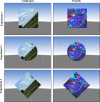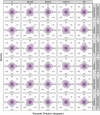Turning the (virtual) world around: Patterns in saccade direction vary with picture orientation and shape in virtual reality
- PMID: 38755788
- PMCID: PMC7443121
- DOI: 10.1167/jov.20.8.21
Turning the (virtual) world around: Patterns in saccade direction vary with picture orientation and shape in virtual reality
Abstract
Research investigating gaze in natural scenes has identified a number of spatial biases in where people look, but it is unclear whether these are partly due to constrained testing environments (e.g., a participant with their head restrained and looking at a landscape image framed within a computer monitor). We examined the extent to which image shape (square vs. circle), image rotation, and image content (landscapes vs. fractal images) influence eye and head movements in virtual reality (VR). Both the eyes and head were tracked while observers looked at natural scenes in a virtual environment. In line with previous work, we found a bias for saccade directions parallel to the image horizon, regardless of image shape or content. We found that, when allowed to do so, observers move both their eyes and head to explore images. Head rotation, however, was idiosyncratic; some observers rotated a lot, whereas others did not. Interestingly, the head rotated in line with the rotation of landscape but not fractal images. That head rotation and gaze direction respond differently to image content suggests that they may be under different control systems. We discuss our findings in relation to current theories on head and eye movement control and how insights from VR might inform more traditional eye-tracking studies.
Figures







Similar articles
-
Head Orientation Influences Saccade Directions during Free Viewing.eNeuro. 2022 Dec 21;9(6):ENEURO.0273-22.2022. doi: 10.1523/ENEURO.0273-22.2022. Print 2022 Nov-Dec. eNeuro. 2022. PMID: 36351820 Free PMC article.
-
Visual exploration of omnidirectional panoramic scenes.J Vis. 2020 Jul 1;20(7):23. doi: 10.1167/jov.20.7.23. J Vis. 2020. PMID: 32692829 Free PMC article.
-
Eye and head movements while looking at rotated scenes in VR. Session "Beyond the screen's edge" at the 20th European Conference on Eye Movement Research (ECEM) in Alicante, 19.8.2019.J Eye Mov Res. 2019 Nov 25;12(7):10.16910/jemr.12.7.11. doi: 10.16910/jemr.12.7.11. J Eye Mov Res. 2019. PMID: 33828771 Free PMC article.
-
Eye Tracking in Virtual Reality.Curr Top Behav Neurosci. 2023;65:73-100. doi: 10.1007/7854_2022_409. Curr Top Behav Neurosci. 2023. PMID: 36710302
-
Head-Mounted Virtual Reality and Mental Health: Critical Review of Current Research.JMIR Serious Games. 2018 Jul 6;6(3):e14. doi: 10.2196/games.9226. JMIR Serious Games. 2018. PMID: 29980500 Free PMC article. Review.
Cited by
-
Head Orientation Influences Saccade Directions during Free Viewing.eNeuro. 2022 Dec 21;9(6):ENEURO.0273-22.2022. doi: 10.1523/ENEURO.0273-22.2022. Print 2022 Nov-Dec. eNeuro. 2022. PMID: 36351820 Free PMC article.
-
Eye and head movements while encoding and recognizing panoramic scenes in virtual reality.PLoS One. 2023 Feb 17;18(2):e0282030. doi: 10.1371/journal.pone.0282030. eCollection 2023. PLoS One. 2023. PMID: 36800398 Free PMC article.
-
The deep past in the virtual present: developing an interdisciplinary approach towards understanding the psychological foundations of palaeolithic cave art.Sci Rep. 2023 Nov 3;13(1):19009. doi: 10.1038/s41598-023-46320-8. Sci Rep. 2023. PMID: 37923922 Free PMC article.
-
Gaze During Locomotion in Virtual Reality and the Real World.Front Neurosci. 2021 May 24;15:656913. doi: 10.3389/fnins.2021.656913. eCollection 2021. Front Neurosci. 2021. PMID: 34108857 Free PMC article.
-
Visual exploration of omnidirectional panoramic scenes.J Vis. 2020 Jul 1;20(7):23. doi: 10.1167/jov.20.7.23. J Vis. 2020. PMID: 32692829 Free PMC article.
References
-
- Birmingham E., Bischof W. F., & Kingstone A. (2008). Gaze selection in complex social scenes. Visual Cognition, 16(2–3), 341–355.
LinkOut - more resources
Full Text Sources

